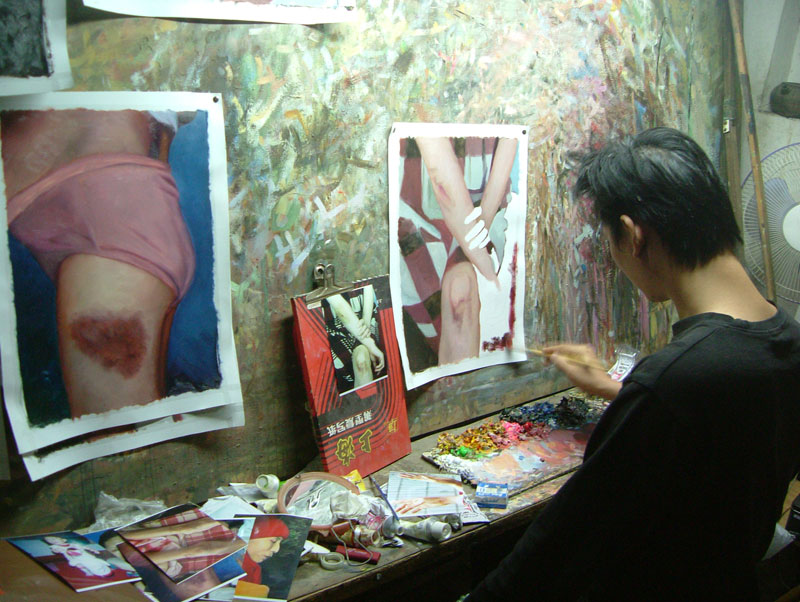

MADE IN CHINA: Selected works from 2007 – 2011
Brody & Paetau started producing paintings in China in 2007 with the exhibition „Painting China Now“. The exhibition was made out of an installation of 30 oil paintings (30cm X 40cm) depicting victims of torture inflicted by the Chinese government upon their own citizens. All paintings were painted in China according to found photographs documenting Falun Dafa members victims of torture in China. These images are censored in China. Accordingly, out of the 20 painting factories that the artists contacted, only 2 companies accepted to produce the work and sent the artists a price offer. Since then Brody & Paetau have employed their „Chinese assistants“ on several occasions, exploiting the cheap labour and challenging the viewers‘ sense of artistic quality with the Made in China label.
Made in China is one of the most recognizable labels in the world today due to China’s rapidly developing large manufacturing industry. The country is the largest exporter in the world and the Made in China label can be seen on a huge range of goods from clothing to electronics. A series of scandals concerning exports, sweatshops, human rights offenses and torture have harmed the „Made in China“ brand, but the western art world has nevertheless been eager to establish galleries in China and to sell chinese art on the western art market. Brody & Paetau however, are more interested in the outsourcing/offshoring phenomenon and in testing the limits of their own strategy. They exploit the critical potential of outsourcing to China and make good use of the specific technical abilities of their chinese assistants to ‚re-produce‘ any picture in a realistic manner for unbeatable production prices. Brody & Paetau demonstrate that any artist can afford to work with assistants, thus imitating in an ironical way the production process of well known contemporary artists who employ dozens of assistants in order to fill the demand of production of an avid global art market. The critical strategy of the works could be described as ‚homeopathic‘ in the sense of: ‚let like be cured by like‘, by re-enacting and thus calling the attention of the public on problematic phenomenons related to politics, power, economy, and the hypocrisy of the western world facing a totalitarian country as a business partner. The ‚China problem‘ is far from being resolved and the western art world is not exempted from it – as recent scandals continue to prove with the recent abusive detention of Chinas best known artist Ai Weiwei.

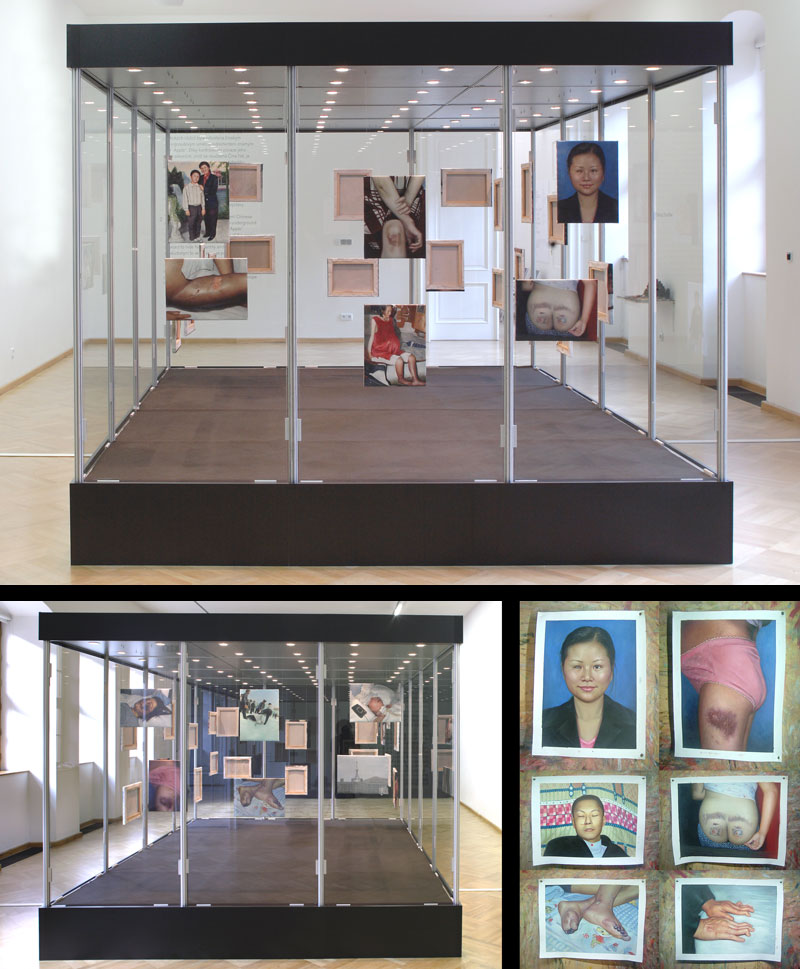
Painting China Now (2007)
An installation of 30 oil paintings (30cm X 40cm) depicting victims of torture inflicted by the Chinese government upon their own citizens. All paintings were painted in China according to found photographs documenting Falun Dafa members victims of torture in China. These images are censored in China. Accordingly, out of the 20 painting factories that we contacted, only 2 companies accepted to produce the work and sent us a price offer.

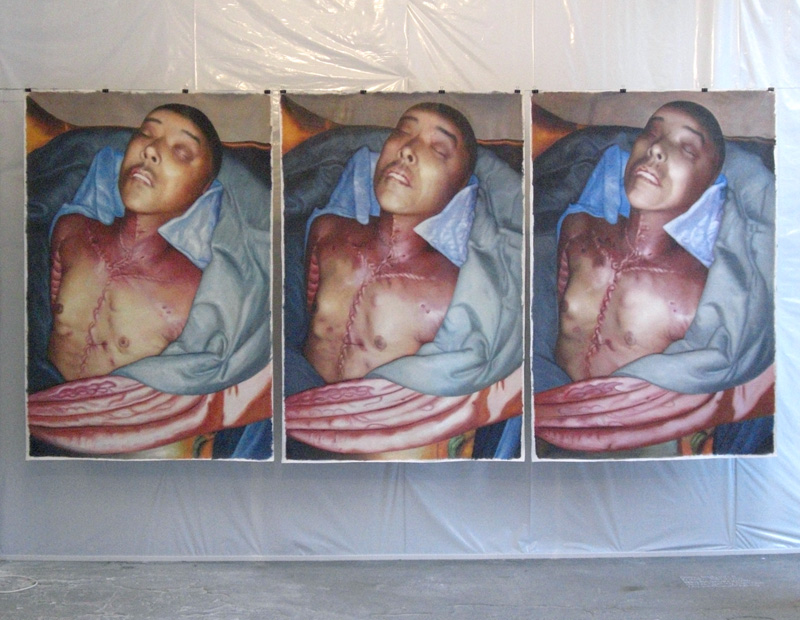
Wang Bin Torture in Commercial Quality, High Quality and Museum Quality (2010)
In their new work: ‘Wang Bin Torture in Commercial Quality, High Quality and Museum Quality’ the artists chose an extremely explicit photograph focusing on the massacred torso of a torture victim. Although the original photograph is unsharp, there is no doubt about what it is depicting. Using the Chinese oil painting companies’ own product quality grade system, Brody & Paetau commisioned the image to be painted in all three grades: Commercial Quality, High Quality and Museum Quality, each painting measuring 110 cm X 160 cm. What at the first glance appears as cynical artistic exploitation can also be seen as a shock of realities revealed through a conceptual artistic process. On one hand, most civilized countries condemn torture and censorship, on the other, they are eager to profit from Chinas‘ cheap production forces and ruthless commercialism. The marketing of art in ‚Commercial Quality, High Quality, and Museum Quality‘ is alien to general gallery practice as the artistic and monetary value of a painting is usually not relative to labor time or technical skill.
Wang Bin, born on August 2, 1956, was a computer software engineer at the Institute of Exploration and Development in the Daqing Petroleum Field. He had received science and technology awards on many occasions, and for three ses- sions in a row, he had been a representative of the employee’s assembly at the institute. The Daqing Men’s Labor Re- education Camp tried to transform Falun Gong practitioners by force. Wang Bin was beaten to death because he refused to write letters of repentance. The criminals who beat Wang Bin to death include prisoners Cang Shuangcheng, Song Baocheng and Liu Qinghui, as well as police officers on duty: Feng Xi, Lu Renggeng and Wen Qiang (who has since left his post). The three prisoners kept beating Wang Bin for over 40 minutes, until he had only one breath left. During the beating, Feng Xi was twice informed of Wang’s situation, but he still leisurely enjoyed watching the torture. Lu Renggeng inspected Wang several times while he was on duty, and when Wang Bin died, he ordered prisoners to place Wang Bin on the balcony to cool off a little. At 11 PM on September 24, 2000, Wang Bin was sent to the hospital and examined by Li Jibiao, the doctor who was on duty. The results turned out to be miserable: a lymph artery was broken; over a dozen of his bones, including his collar bone, sternum and ribs were broken; one of Wang’s testicles was also split; the backs of Wang’s hands were found to have been repeat- edly burned; Wang’s nostrils were burned and injured by the lit cigarettes that were inserted into them; and many parts of Wang’s body were black and dark purple.

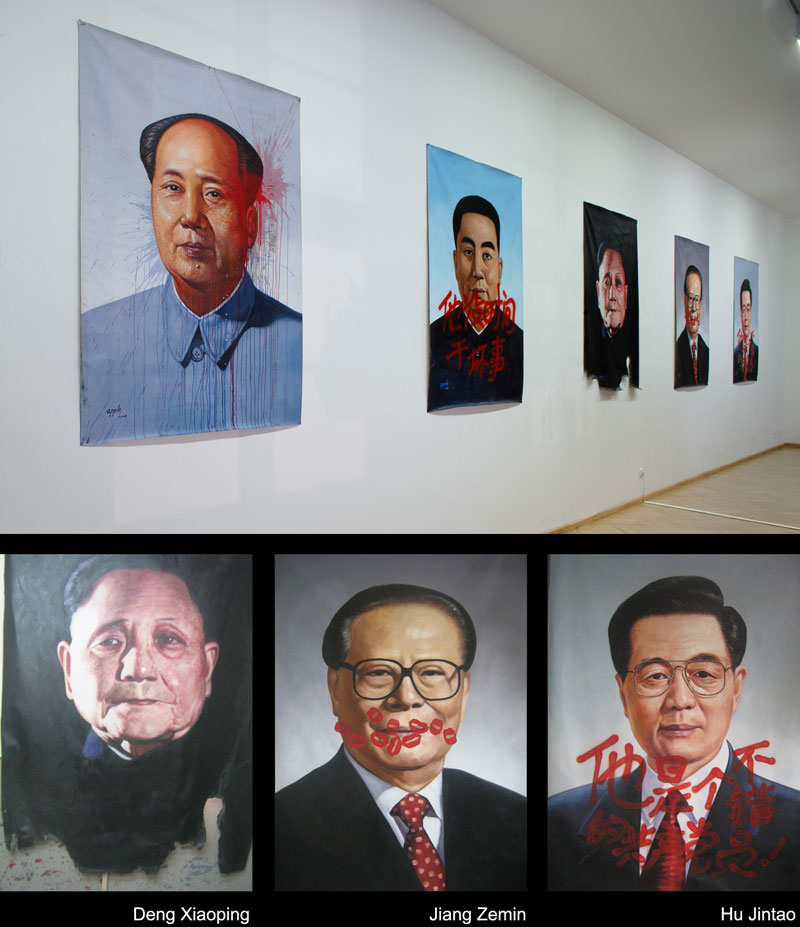
Respect the Leaders 2008
This series of 5 portraits of prominent Chinese political leaders were created by an underground Chinese dissident artist known as ‚Apple‘. Because of the controversial nature of the works, and the laws governing modern China, ‚Apple‘ is forced to hide his identity and to work under a pseudonym to avoid serious persecution. Once the paintings are completed, ‚Apple‘ and his collaborators ‚vandalized‘ the works in a series of anti-government performances. These completed paintings were purchased and shipped to Europe for this exhibition.

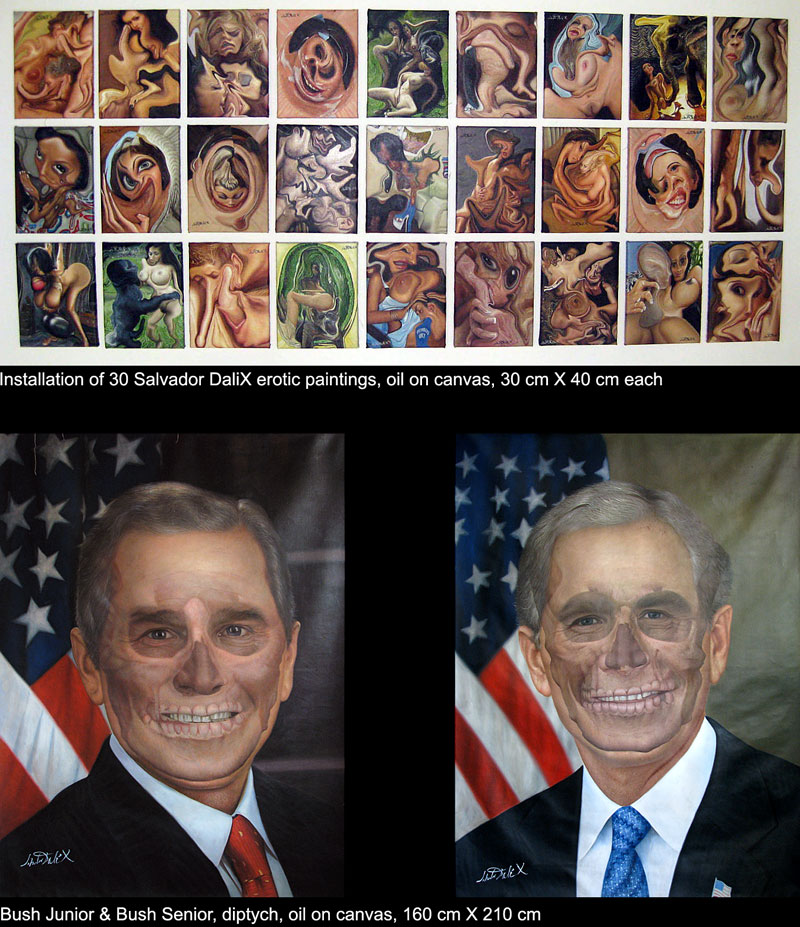
Salvador DaliX 2008
The Salvador DaliX paintings are mainly based on pornographic and some political photographs stolen from the internet, then manipulated with the computer and finally painted by ‘my assistants’ in China: commercial painting companies who specialize in reproducing any picture you e-mail them. All the paintings are ‘original’ oil on canvas – handmade of course. It seems that the ‘Made in China’ stamp devaluates the commercial value of the paintings even more than the fact that they were painted by (a poor artists) assistants. At the same time many people admire paintings of famous contemporary artists that are produced by chinese, russian or eastern european assistants who paint for 10 US dollars an hour in New York, Berlin and London. The Salvador DaliX paintings refer to many contradictions and problematic aspects (conceptual, economical, political and visual) that I find interesting.


Child Picassos 2008
Copies of paintings made by immigrant school children in Berlin after works by Pablo Picasso. The 9 paintings (oil on canvas, 30 X 40 cm) were re-painted in 2008 by my chinese assistants.

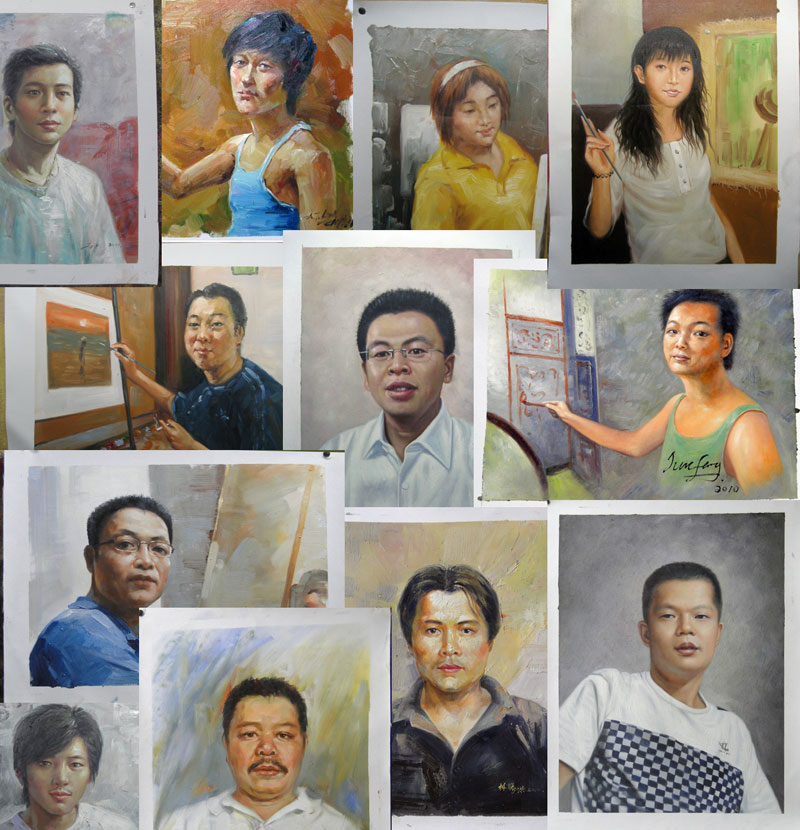
Chinese Assistants 2011
“I have an unusual request for you. I would like to have a series of self-portraits from the assis- tants/painters from your company. Do you think it would be possible if each assistant would paint a self-portrait for me ? The self-portrait technique and visual look would be entirely up-to the creativity and aesthetic decision of each painter. Please let me know if this would be possible.â€
“Thanks for your email. We had planned to create these paintings by truelife paint way and make them accurately from their original photos ( I sent them to you in my previous email). If so, the finished paintings will be same as the original photos. Now, I understand your meaning and you don’t like us to make them as my above paint ways. What you need us to do is ‚ Let each artist make his private portrait painting by his ideals and different styles, for example, abstract paint style, impressionism paint style, white and black paint style, etc‘. Ok, we will do them by your this instruction paint style. If it is ok, please kindly arrange the deposit and we will begin with them. Looking foward to your comments.Have a nice day.â€

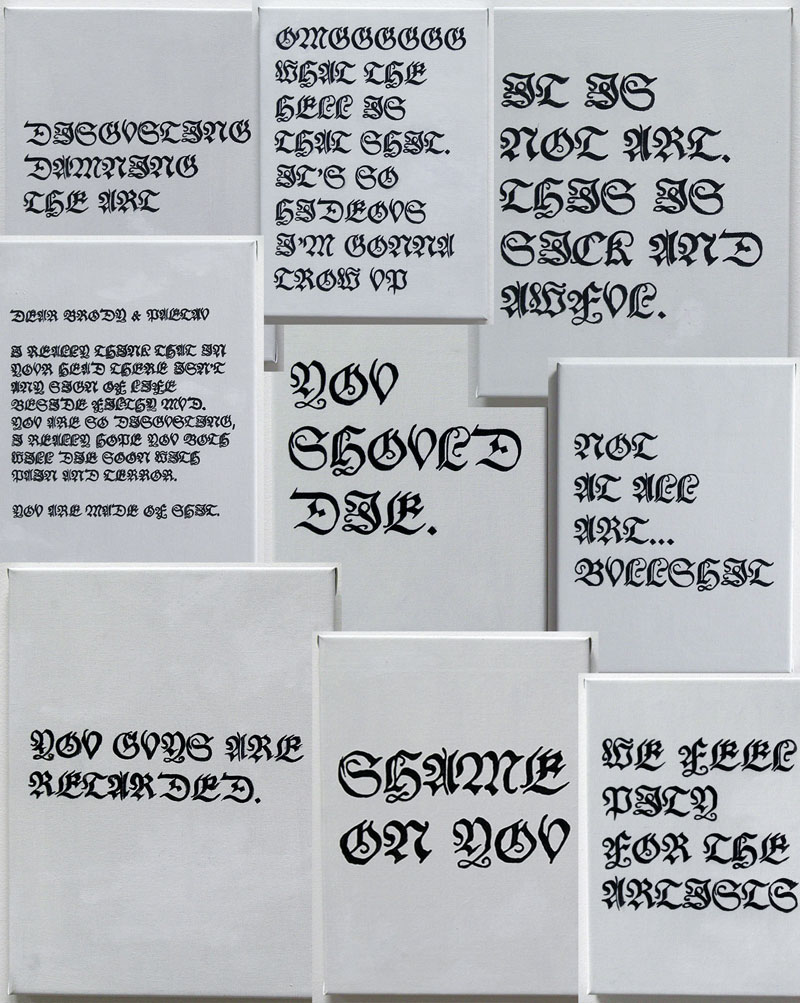
Critique Paintings 2010
The idea of the Critique Paintings came from the numerous negative critiques that people write on our website as a response to our works. While reading the critiques the impression arouse that our work is perceived as ‘degenerate’ by many people. We decided to paint a selection of 30 critiques referring to our work in a calligraphic manner using the Schwabacher typography. These ‘critique paintings’ point out the degeneracy of our art. 30 oil paintings on canvas, each 30 cm X 40 cm.










Between cynical exploitation and parodical critique : I don’t know which aspect is more representative of these different series ?
I don’t find these series very cynical, rather a funny way to use painting as print-on-demand…
stupid and not art, poor chinese!
arrogant western artists fuck you!
Wether I like the paintings or not is secondary but they do question several problematic aspects of contemporary art production in relation to our consumer society and politics of cheap global outsourcing to China
I am very moved by these art projects! Conceptually they are brilliant, and a deep profundity and poignantcy can be experienced in the viewing of them.
gostei muito da tortura comercial, quero encomendar uma para o meu escritório de advocacia.
the art project is impressed, but the art technique of the artworks in the project painted by a painting factory in south of china is too poor, which looked like a junk or „Hong Kong Oils“
Powerful work Ondrej and Kristofer. Congratulations.
We are completely according to your positions regarding to the art and the violation of the human rights.
You guys are doing amazing work
complimenti!!! la cruda sofferenza dei nostri giorni è rappresentata alla perfezione!
Hey, congrats. It’s fu### great.
thanks for this, ondrej and kristofer. super interesting work.
I think this subject is very interesting!
always I like to receive news of your beautiful work 🙂
artist plz! Dont our source your art making to China! Even though it’ll make you look cool. Instead work with your local craft people http://oree.storijapan.net/ (crying out loud).
very powerful form for sending your message – the Wang Bin Torture tryptych is exceptional – MJS
BLAH
Another BLAH